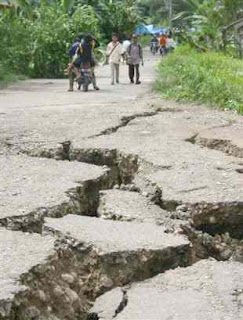
All tectonic plates have internal stress fields caused by their interactions with neighbouring plates and sedimentary loading or unloading (e.g. deglaciation). These stresses may be sufficient to cause failure along existing fault planes, giving rise to intraplate earthquakes.
Earthquakes often occur in volcanic regions and are caused there, both by tectonic faults and the movement of magma in volcanoes. Such eartquakes can serve as an early warning of volcanic eruptions, like during the Mount St. Helens eruption of 1980. Earthquake swarms can serve as markers for the location of the flowing magma throughout the volcanoes.
Most earthquakes form part of a sequence, related to each other in terms of location and time. Most earthquake clusters consist of small tremors which cause little to no damage, but there is a theory that earthquakes can recur in a regular pattern. There are around 500,000 earthquakes each year. 100,000 of these can actually be felt. Minor earthquakes occur nearly constantly around the world in places like California and Alaska in the U.S., as well as in Guatemala, Chile, Peru, Indonesia, Iran, Pakistan, the Azores in Portugal, Turkey, New Zealand, Greece, Italy and Japan, but earthquakes can occur almost anywhere, including New York City, London and Australia. Larger earthquakes occur less frequently.
While most earthquakes are caused by movement of the Earth´s tectonic plates, human activity can also produce earthquakes. Four main activities contribute to this phenomenon: construction large dams and buildings, drilling and injecting liquid into wells, and by coal mining and oil drilling. Most earthquakes form part of a sequence, related to each other in terms of location and time.
Shaking and ground rupture are the main effects created by earthquakes, principally resulting in more or less severe damage to buildings and other rigid structures. The severity of the local effects depends on the complex combination of the earthquake magnitude, the distance from the epicenter, and the local geological and geomorphological conditions, which may amplify or reduce wave propagation. The ground-shaking is measured by ground acceleration.
Ground rupture is a visible breaking and displacement of the Earth´s surface along the trace of the fault, which may be of the order of several metres in the case of major earthquakes. Ground rupture is a major risk for large engineering structures such as dams, bridges and nuclear power stations and requires careful mapping of existing faults to identify any likely to break the ground surface within the life of the structure.
Earthquakes, along with severe storms, volcanic activity, coastal wave attack, and wildfires, can produce slope instability leading to landslides, a major geological hazard. Landslide danger may persist while emergency personnel are attempting rescue.
Part 3 will follow...
Thanks for reading!!
Starry Dawn.


No comments:
Post a Comment